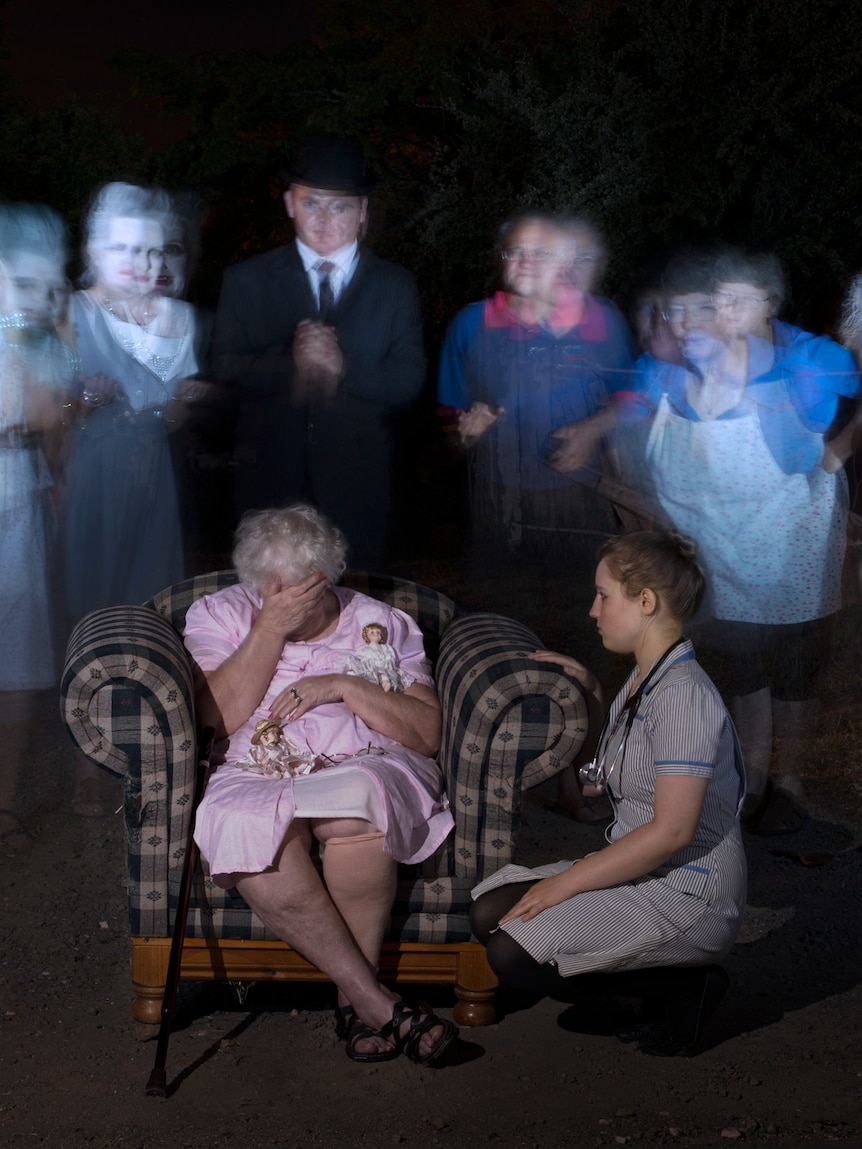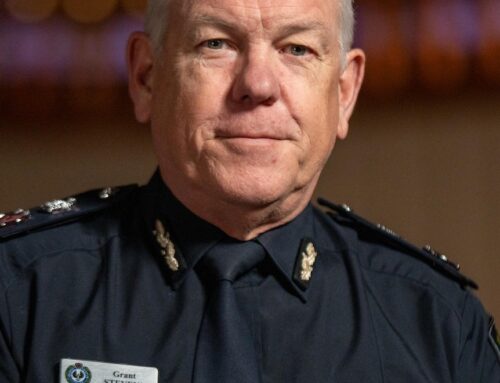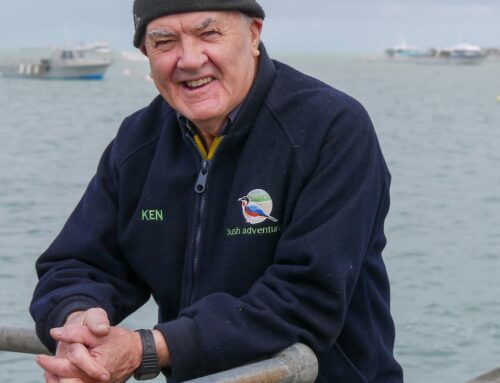A woman stands in the bush, her back turned to the golden sunlight surrounding her.
She is shrouded in darkness, her head turned away from both the beauty and the help that approaches.
It’s one of Christine Sayer’s images — forged in her imagination and brought to life with her camera.
The 63-year-old worked as a photographer, using her craft to depict human experiences that all too often seem invisible.
Dementia.
Neurodiversity.
Mental illness.
Christine had no idea how closely her own life would imitate art.
The photographer has been admitted to public health facilities more than 30 times in the past six years for mental health treatment.
She says at times the system has helped her.
But Christine also believes some of the care she’s received has been degrading and worsened her mental health, despite the best efforts of staff.
“A lot of people who have mental health conditions, we’re marginalised in society,” Christine says.
“If you go to a psychiatric hospital, you’re even more so. If you have more than one visit there, who’s going to believe anything you say?
“I want people who have mental illnesses to be treated with dignity and respect and to be given compassion when they go into hospital.”
Christine says depression changed her outlook and her sense of self.
Supplied: Beth Sayer
The first thing Christine noticed during her stay in Bendigo Health’s acute adult unit was the state of the room around her.
Brown smears on the carpet next to a “visible brown lump”, a red stain on the carpet, a partially detached toilet seat, brown marks on the couch and a dirty window.
“Forty-eight hours later, three cleaners and as many staff members, it appeared the room had just as little hope of being cleaned as I had of surviving this,” Christine wrote in a 14-page complaint to the former Victorian Mental Health Complaints Commissioner.
“I wanted to sign myself out.”
Christine documented the conditions in the room, including “brown poo marks”.
Supplied: Christine Sayer
Bendigo Health’s acute adult unit provides short-term inpatient mental health treatment for people aged 16 to 65.
Like most other rural Victorian mental health services, Bendigo Health’s adult inpatient beds ran above 90 per cent occupancy last financial year.
Christine says being admitted to the adult acute unit used to help, but the care she’s received has dropped in the past two years.
She says she was admitted to dirty and damaged rooms, was not given hourly checks while suicidal, and had to stay in dirty clothes for more than 24 hours.
“I felt humiliated having to ask, and then beg, for my things.”
Christine says cleanliness remained an issue during her most recent admission.
Supplied: Christine Sayer
Christine says she was often too unwell to leave her room, which limited her access to food and beverages.
“When I couldn’t go out of my room, I’d see a nurse for a total of 20 minutes in a 12-hour period … which covers day shift and evening.
“They used to talk to you, the nurses. They don’t have time for that anymore.”
In her complaint to the former Mental Health Complaints Commissioner, Christine wrote that seven days in Bendigo Health’s adult acute unit had reinforced her belief that the world would be a better place without her.
“My voice was ignored, dismissed or not taken seriously,” she wrote.
Victoria’s new Mental Health and Wellbeing Commission investigated and recommended that Bendigo Health make improvements.
In a statement, Bendigo Health said it had acted on all the commission’s recommendations, including reviewing its complaints resolution process, improving its response to cleanliness and maintenance issues, and reviewing processes to care for the physical health needs of mental health service consumers.
The health service said it had also improved training for new staff about risk identification and management.
“Bendigo Health acknowledges the cleanliness of the consumer’s room and elements of her care were below our usual standard during her admission,” a spokesperson said.
The Mental Health and Wellbeing Commission closed Christine’s complaint after Bendigo Health committed to improve on the issues.
Christine says her experiences during a subsequent admission to the adult acute unit were similar.
She says she was left for 24 hours without help to change a catheter earlier this year.
Christine’s psychotherapist, Mark Colletti, says his client’s negative experiences in hospital have made it more challenging to keep her safe when she is most unwell.
“When … I’m worried about things like death by misadventure, or suicidal ideation, the only alternative is to go to hospital,” he says.
“Yet [Christine’s] thought process is, ‘If I go to hospital, I’m going to feel more unsafe than I am here’.
“Do I put my client in a place where they feel unsafe already, or do we maintain a level of risk here?”
Christine has since had positive experiences in another of Bendigo Health’s psychiatric units, with support from Mr Colletti and the rest of her treating team.
Word games, jigsaw puzzles and colouring in help Jenette with her mental health, but it’s not always enough.
Despite her best efforts to manage, the 64-year-old often struggles with self-harm and suicidal ideation.
“Right up until this year, I would get help if I attended the emergency department,” she says.
“But this year, they’re being really rude to me.”
For much of this year, Jenette felt she was being viewed as a pest because of how often she went to the hospital seeking help.
She complained to Bendigo Health about the way she was spoken to at the emergency department, while suicidal, earlier this year.
A few weeks after Jenette said she had that experience, Bendigo Health asked her to sign a care plan, which would restrict her voluntary admissions to a mental health unit.
Jenette wouldn’t agree to it, fearing the plan would give staff greater licence to turn her away when she was most vulnerable.
“It makes me feel angry because I only go up to ED or in triage if I’m really bad,” she says.
“Because I don’t yell and scream, like some do, they think I’m not needy.”
Jenette’s NDIS funding for therapy and other forms of support ran out, months ahead of schedule, leaving her feeling more alone than ever.
Her mental health and wellbeing at home further deteriorated after the reduction in services.
Jenette has been admitted to hospital several times since the plan was drafted, and Bendigo Health has stepped up mental health support.
“Treatment plans do not prevent a person being admitted to hospital if needed,” a Bendigo Health spokesperson said.
“Treatment plans are standard clinical practice for consumers.
“They are designed to support individual recovery in the community and in the individual’s own home.”
Jenette says she just wants to be treated with respect and to receive the support she needs.
“I just hope it doesn’t happen to other people.
“If someone says they’re suicidal, it should be taken seriously.”
Bendigo Health says Jenette and Christine’s experiences do not reflect the usual standard of care provided by its mental health and wellbeing services.
“We are committed to continually enhancing the quality of care we offer to our community,” a spokesperson said.
Victoria is grappling with reforming its mental health system after a royal commission found it had “catastrophically failed to meet expectations and was woefully underprepared for current and future challenges”.
However, people relying on, and working in, the system say not enough has changed in the three years since the royal commission tabled its 10-year plan for reform.
George Skoufis is a worker in public mental health in Victoria who also has lived experience.
“It’s just simply not good enough what people have to experience within the public mental health system currently,” he says.
That is especially true for people who access inpatient units, he says.
“They’re not pleasant environments … not the type of place you’d ever want to have to go to, and typically leave a lot of consumers with more trauma than they actually solve.”
Eminent psychiatrist and former Australian of the Year Patrick McGorry says mental health care in hospitals should be of the same standard people would expect for cancer or heart disease.
“Very high-quality, with tremendous respect and compassionate care.”
A 2023 survey of Victorian Health and Community Services Union members working in public mental health showed fewer than half felt positive about their work, and many were struggling to pay their rent or service their mortgage.
“Mental health workers are at breaking point,” the union’s state secretary, Paul Healey, says.
Occupational violence, high workloads, short staffing, and increasingly complex cases are among the key challenges the sector’s workers face, with negotiations for the public mental health services enterprise agreement underway.
Mr Skoufis says workers are under “quite extreme” stress.
“While there are good people trying to make a real impact in the industry, we simply don’t have the ability to provide the care that the public deserves.”
The Victorian government committed to implement all the royal commission’s recommendations and to make people with lived experience “central to the design and delivery of the new mental health and wellbeing system”.
However, key stakeholders say they are uncertain about the government’s plan for reforms after work on several royal commission recommendations was either delayed or not funded in this year’s state budget.
There was no funding for a Lived and Living Experience Agency, and the rollout of Mental Health and Wellbeing Locals — aimed at helping people over 26 get support — has slowed, with 15 established.
“We simply can’t deliver these reforms, or the first-rate care Victorians deserve, without the workforce behind us,” the budget papers said, highlighting the need for an additional 2,500 mental health workers.
“An evaluation of the existing rollout and a plan for the next phase of the work will be done prior to the next budget.”
The government says it has made “significant progress” since the royal commission’s final report in 2021 and is leading the way for health reform nationally, with work underway to implement more than 90 per cent of the recommendations and more than $6 billion invested.
“We remain absolutely determined to deliver on the royal commission recommendations,” Premier Jacinta Allan says.
“The need for this is even more so than when we first called for the commission to do its work.”
The government did not respond to the ABC’s questions about how it was considering changing its approach to reforms and the timeframe for delivery.
However, the government on Friday released its new suicide prevention strategy and reiterated its commitment to implementing the royal commission’s reforms.
The Mental Health and Wellbeing Commission has requested information from the government about the future of mental health reforms, including plans to address workforce pressures.
“We are strongly encouraging government to be transparent with its future plans for the royal commission implementation and are working hard to ensure stakeholders get the answers and direction they need,” a commission spokesperson said.
Emily Wolter, the acting chief executive of peak body Mental Health Victoria, says it wants to ensure momentum is not lost.
“We need to see this change,” she says.
Victorian Mental Illness Awareness Council chief executive Vrinda Edan says people with lived experience are disappointed there has not been more substantial improvement.
“What we’re seeing at the moment doesn’t look like it’s sustainable or achieving anywhere near the level of change that people wanted and expected, and in some ways were set up by the royal commission and the speeches that were done at the time the report was released to expect,” she says.
The royal commission recommended interim regional bodies be replaced by legislated Regional Mental Health and Wellbeing boards “by no later than the end of 2023”, so they could plan for the future of services and engage with their communities.
The Victorian government’s website states that eight interim regional bodies were established in 2022 but it does not mention a timeframe for the boards.
“It’s really important that we see those reforms back on track sooner rather than later,” shadow mental health minister Emma Kealy said.
Professor McGorry chaired the royal commission’s expert advisory committee and says reforms to Victoria’s mental health system must be led by experts.
“We need to identify what are the most strategic and transformational things we could do to not just end up with a much better system, but address the incredible stresses and strains that are on the current system which people are really suffering from at the moment.”
More Victorians are considered active mental health consumers now than in the past four years, even though the number of new consumers is comparable to last year, state health data shows.
Mental health-related presentations to Victorian emergency departments have been at a four-year high for most of this year, particularly in people over 65.
Many people are re-presenting to emergency departments within 48 hours, and there was a spike mid-year in people with mental health concerns spending more than 24 hours in emergency.
Just over 45 per cent of adults are transferred from emergency departments to mental health beds within eight hours.
Meanwhile, Suicide Prevention Australia data shows three-quarters of Australians are feeling elevated levels of distress, pushing support services to the brink, as the federal government seeks to improve the nation’s approach to suicide prevention.
Paul Healey, from the Health and Community Services Union, says the challenges the mental health system face don’t justify negative experiences for consumers.
“There’s no excuse for people who have been sitting in unsanitary conditions or not being able to access food and medication.”
He says mental health workers are concerned about the increased rate of suicide in the state, with more than 450 lives lost so far this year.
“The system is not keeping up and keeping people safe.”
The Coroners Court of Victoria recorded 801 deaths by suicide in 2023, up from 761 the previous year.
The government’s new strategy acknowledges more needs to be done to prevent suicidal distress.
“We are working to deliver robust suicide prevention and support measures that are safe, accessible and respectful to all Victorians, no matter who they are or where they live,” Ingrid Stitt, the Minister for Mental Health, says.
Professor McGorry and other mental health experts are calling for programs that offer intensive mental health support at home to be expanded.
Both Barwon Health and Orygen offer Mental Health Hospital In The Home initiatives, with Barwon Health’s program providing the equivalent of 245 bed days of care a month.
“It takes enormous pressure off the hospital-based system and emergency departments,” says Professor McGorry, who is Orygen’s executive director.
This is the moment Christine picked up her camera for the first time in six years.
Her depression has at times robbed her of her ability to take photographs so until recently she was writing to express herself.
A piece she wrote is now being used to give nursing students an insight into what patients are battling.
Christine’s depression continues, but after years of trying different forms of treatment, it’s improving.
She credits her treating team with helping her rediscover her voice and her self-worth.
Among those she thanks are staff at Bendigo Health.
Credits
- Reporting: Emma D’Agostino
- Photography: Emma D’Agostino, Sean Warren, Christine Sayer and Beth Sayer
- Video: Emma D’Agostino
- Illustrations: Sharon Gordon
- Digital production: Daniel Franklin




